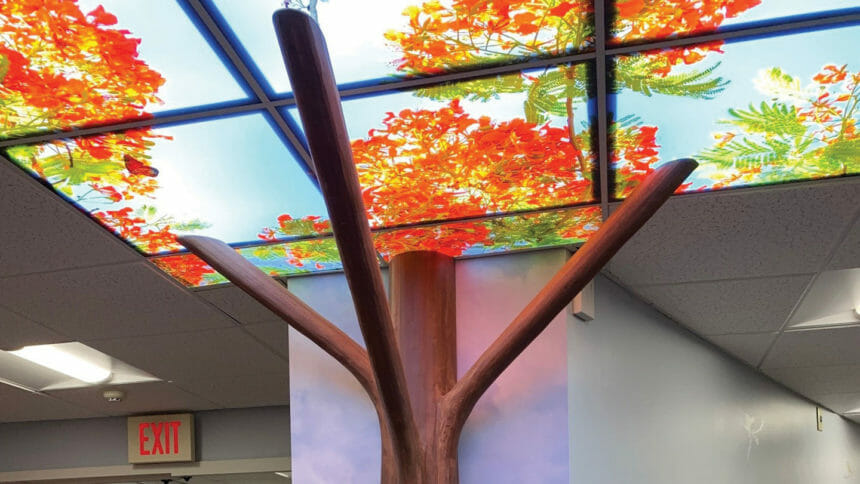
Bruce Springsteen once asked, “Does this bus stop at 82nd Street?” The song was about New York, but it also applies to Lawrence, MA, home to the Mary Immaculate Health/Care Services and its innovative new Memory Care Unit.
The Bus Stop has become a popular meeting place for cognitively challenged skilled nursing residents, and even though the bus never comes, the stop has an important purpose, says Rebecca Alfonso, program director for memory care.
“It’s a popular people-watching spot, like a porch,” she says. “It also serves as a place for reminiscing, like, ‘What bus number did you take to work?’ After a while, it becomes a natural way to say, ‘Let’s go get a drink while we wait.’”
The Bus Stop is one component of a design theme that follows the Alzheimer’s Association Habilitation Therapy Program, which creates a world patterned after residents’ earlier lives. The $500,000 project features similar elements such as the Meeting Tree, the Post Office, the Memory Garden and Quiet Room.
The 41-unit Memory Care Center is part of a comprehensive eldercare campus, which includes 231 skilled nursing beds. The project took about two years to complete, says MIHCS CEO Jeanne Leydon.
“We did a lot of the work ourselves,” she says. “We had volunteers to paint, build closets and shelving.”
Leydon credits retired maintenance director John Raymond with creative vision on elements like the Back Porch. Residents can sit on a couch or in glider chairs to view a landscape mural beyond a handmade porch railing.
Aesthetic and functional details are paramount in the décor, designed to enable “wayfinding” for residents, while furnishing materials that promote safety. Three neighborhood styles are based on resident demographics and area history — stucco represents the Latinx population, clapboard represents the working class and brick is reminiscent of the town’s factory-working past.
Each neighborhood is designed in a specific color that assists a resident in navigating their way back “home.” Light fixtures, color-coded doors and mail slots are part of each resident’s entrance for instant recognition. Flooring is tactile, skid-resistant and has a cushioned underlayer to prevent injuries.
As a dementia specialist, Alfonso carefully researched the environmental aspects of the design to create “a positive and relaxed” atmosphere. Working with a design committee, Alfonso and the group determined which materials offered the most resident protection.
The Memory Care Center’s approach is a radical departure from conventional methods, Leydon says, because it employs holistic sensibilities and empathy for residents.
“Research has come a long way — we’ve learned that antipsychotics and tranquilizers don’t do well with dementia,” she says. “We have created an environment where residents feel comforted and in control. It’s a concept of environment over pharmaceuticals.”
From the October 2021 Issue of McKnight's Long-Term Care News




